Abstract
This study looked at the possible association between alcohol abuse and free radical mediated oxidative injury by examining the presence of oxidative damage, as monitored by erythrocyte malonildialdehyde and plasma lipid hydroperoxides, in patients with liver cirrhosis and different lifetime daily alcohol intake. All patients with an alcohol intake above 100 g/day (ALC) showed concentrations of malonildialdehyde and lipid hydroperoxide on average four to fivefold higher than cirrhotic patients with alcohol intake below 100 g/day (NAC) or healthy controls. Further subgrouping of ALC patients showed that those with alcohol intake ranging between 100 and 200 g/day (ALC1) had malonildialdehyde and lipid hydroperoxide concentrations significantly lower than those with an intake higher than 200 g/day (ALC2). These differences were not related to the extent of liver injury or to the liver derangement as assessed by Child's classification. The increase in lipid peroxidation markers in ALC cirrhotic patients was associated with a decrease in, respectively, plasma alpha-tocopherol and erythrocyte glutathione concentrations. Significant differences were also seen between ALC1 and ALC2 groups in plasma alpha-tocopherol, but not in erythrocyte glutathione concentrations. The concentrations of alpha-tocopherol and glutathione in the blood of NAC patients were in contrast not substantially different from those of healthy controls. The close association between oxidative damage and alcohol abuse suggested that free radical intermediates produced during ethanol metabolism might be responsible for causing oxidative damage.
Full text
PDF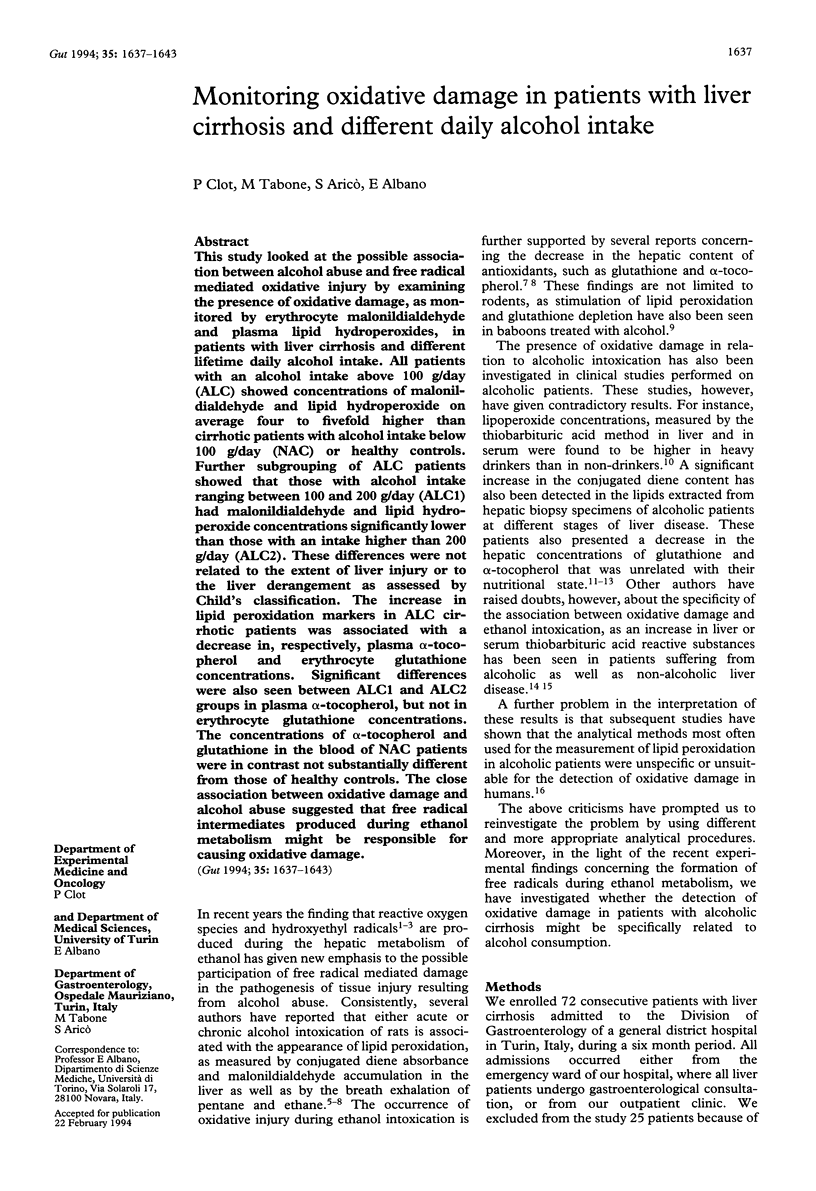
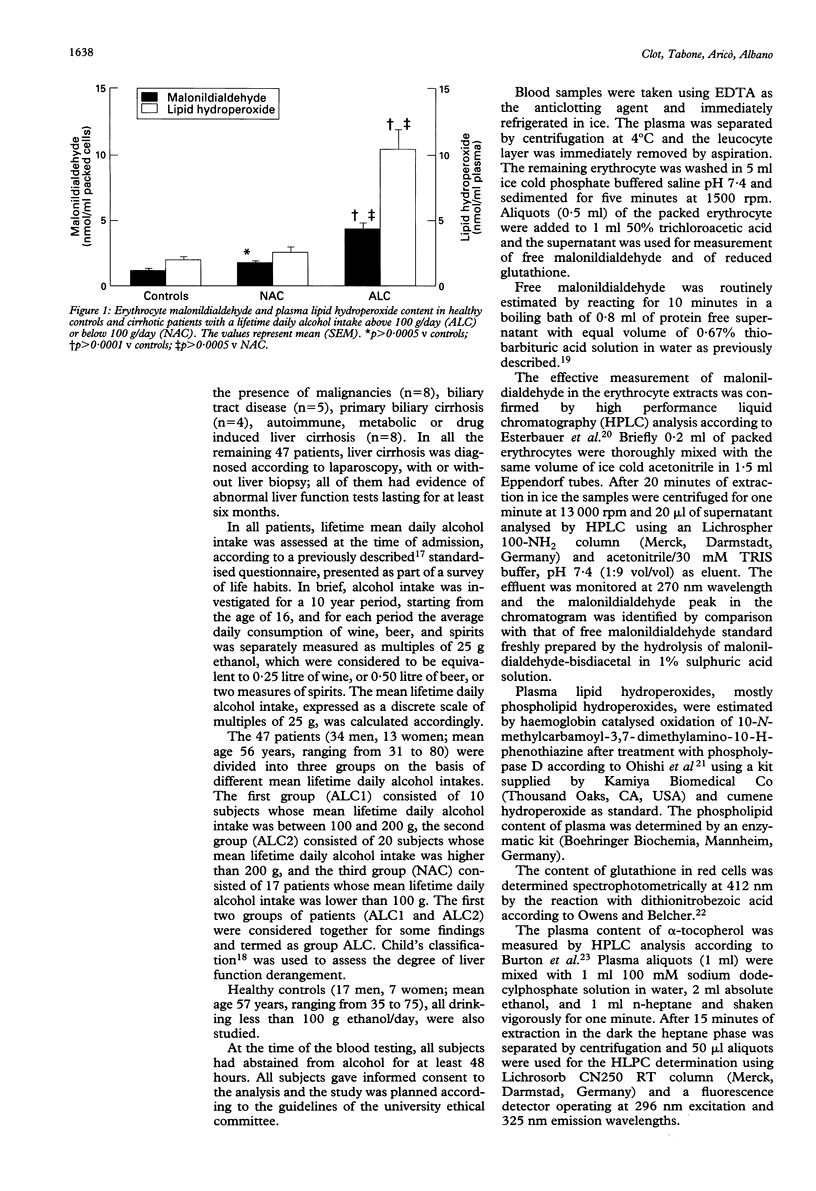
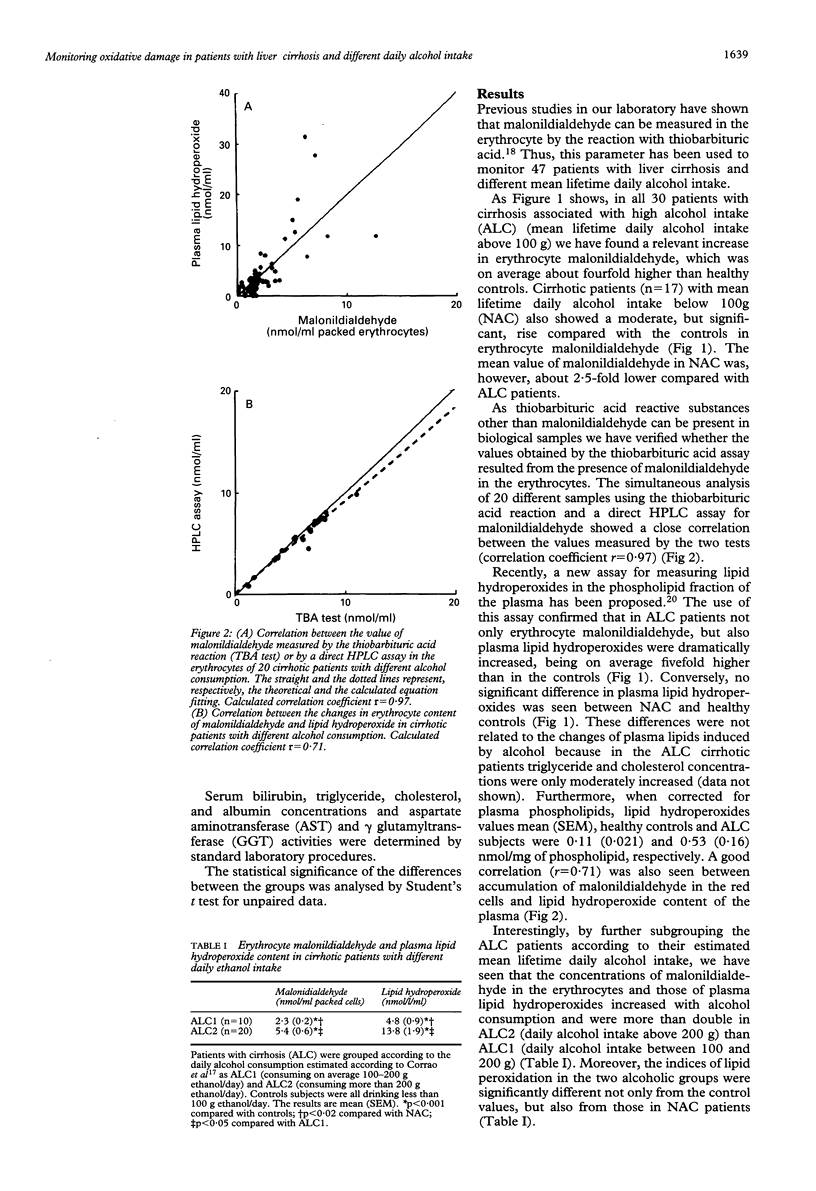
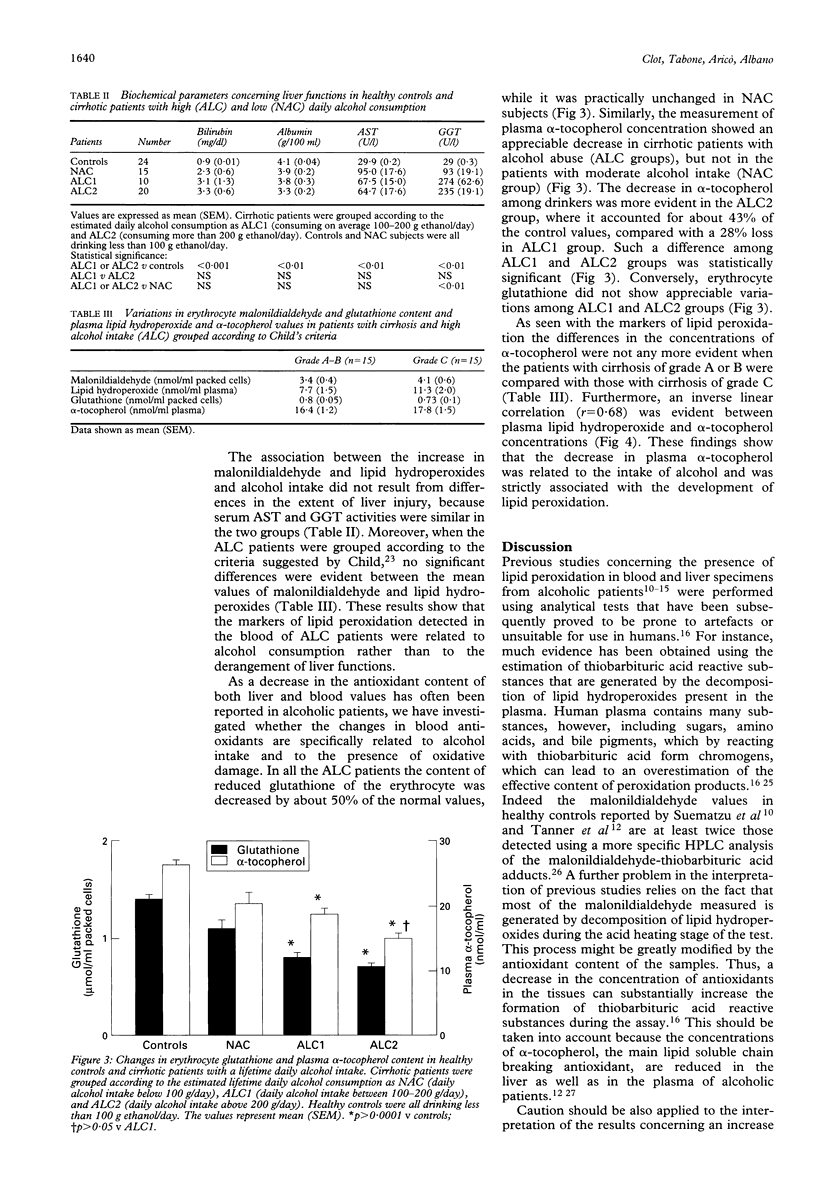
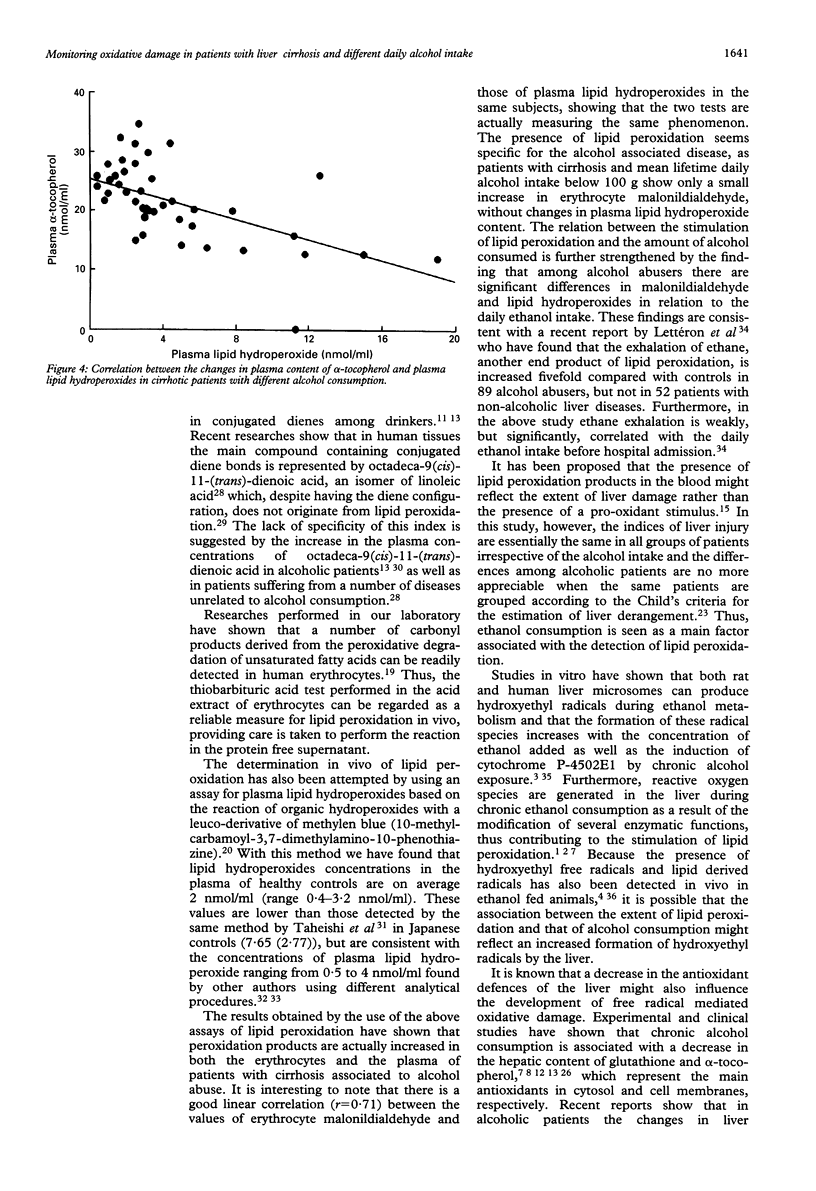
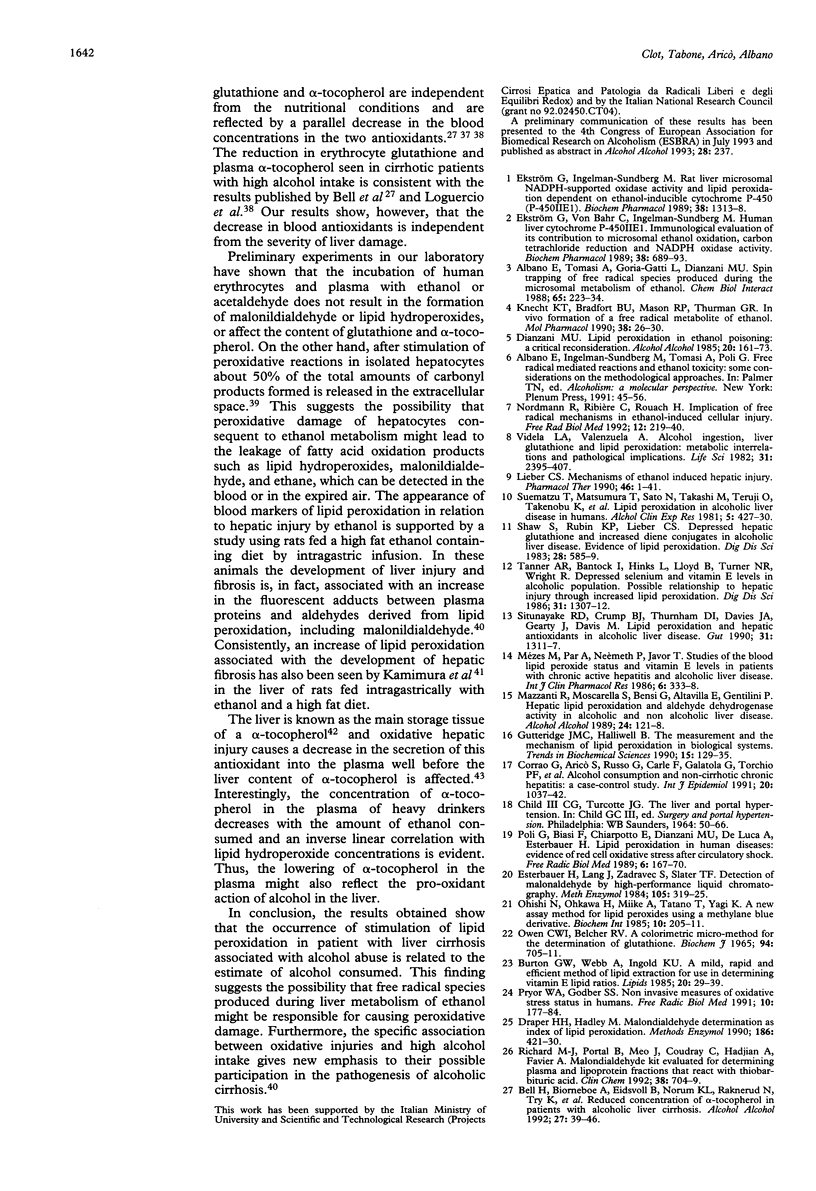
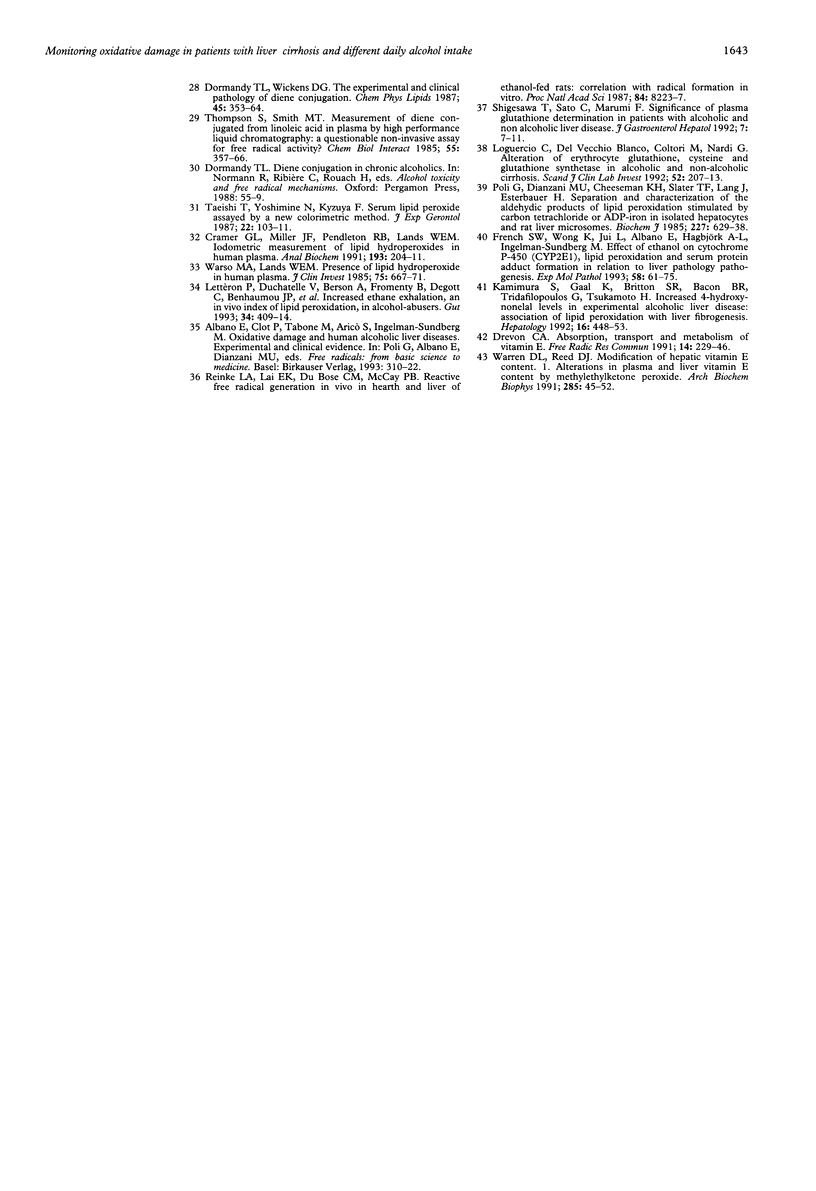
Selected References
These references are in PubMed. This may not be the complete list of references from this article.
- Albano E., Tomasi A., Goria-Gatti L., Dianzani M. U. Spin trapping of free radical species produced during the microsomal metabolism of ethanol. Chem Biol Interact. 1988;65(3):223–234. doi: 10.1016/0009-2797(88)90108-1. [DOI] [PubMed] [Google Scholar]
- Bell H., Bjørneboe A., Eidsvoll B., Norum K. R., Raknerud N., Try K., Thomassen Y., Drevon C. A. Reduced concentration of hepatic alpha-tocopherol in patients with alcoholic liver cirrhosis. Alcohol Alcohol. 1992 Jan;27(1):39–46. [PubMed] [Google Scholar]
- Burton G. W., Webb A., Ingold K. U. A mild, rapid, and efficient method of lipid extraction for use in determining vitamin E/lipid ratios. Lipids. 1985 Jan;20(1):29–39. doi: 10.1007/BF02534359. [DOI] [PubMed] [Google Scholar]
- Corrao G., Arico S., Russo R., Carle F., Galatola G., Torchio P. F., Moiraghi A. R., di Orio F., de la Pierre M. Alcohol consumption and non-cirrhotic chronic hepatitis: a case-control study. Int J Epidemiol. 1991 Dec;20(4):1037–1042. doi: 10.1093/ije/20.4.1037. [DOI] [PubMed] [Google Scholar]
- Cramer G. L., Miller J. F., Jr, Pendleton R. B., Lands W. E. Iodometric measurement of lipid hydroperoxides in human plasma. Anal Biochem. 1991 Mar 2;193(2):204–211. doi: 10.1016/0003-2697(91)90010-q. [DOI] [PubMed] [Google Scholar]
- Dianzani M. U. Lipid peroxidation in ethanol poisoning: a critical reconsideration. Alcohol Alcohol. 1985;20(2):161–173. [PubMed] [Google Scholar]
- Dormandy T. L., Wickens D. G. The experimental and clinical pathology of diene conjugation. Chem Phys Lipids. 1987 Nov-Dec;45(2-4):353–364. doi: 10.1016/0009-3084(87)90072-7. [DOI] [PubMed] [Google Scholar]
- Draper H. H., Hadley M. Malondialdehyde determination as index of lipid peroxidation. Methods Enzymol. 1990;186:421–431. doi: 10.1016/0076-6879(90)86135-i. [DOI] [PubMed] [Google Scholar]
- Drevon C. A. Absorption, transport and metabolism of vitamin E. Free Radic Res Commun. 1991;14(4):229–246. doi: 10.3109/10715769109088952. [DOI] [PubMed] [Google Scholar]
- Ekström G., Ingelman-Sundberg M. Rat liver microsomal NADPH-supported oxidase activity and lipid peroxidation dependent on ethanol-inducible cytochrome P-450 (P-450IIE1). Biochem Pharmacol. 1989 Apr 15;38(8):1313–1319. doi: 10.1016/0006-2952(89)90338-9. [DOI] [PubMed] [Google Scholar]
- Ekström G., von Bahr C., Ingelman-Sundberg M. Human liver microsomal cytochrome P-450IIE1. Immunological evaluation of its contribution to microsomal ethanol oxidation, carbon tetrachloride reduction and NADPH oxidase activity. Biochem Pharmacol. 1989 Feb 15;38(4):689–693. doi: 10.1016/0006-2952(89)90217-7. [DOI] [PubMed] [Google Scholar]
- Esterbauer H., Lang J., Zadravec S., Slater T. F. Detection of malonaldehyde by high-performance liquid chromatography. Methods Enzymol. 1984;105:319–328. doi: 10.1016/s0076-6879(84)05041-2. [DOI] [PubMed] [Google Scholar]
- French S. W., Wong K., Jui L., Albano E., Hagbjork A. L., Ingelman-Sundberg M. Effect of ethanol on cytochrome P450 2E1 (CYP2E1), lipid peroxidation, and serum protein adduct formation in relation to liver pathology pathogenesis. Exp Mol Pathol. 1993 Feb;58(1):61–75. doi: 10.1006/exmp.1993.1006. [DOI] [PubMed] [Google Scholar]
- Gutteridge J. M., Halliwell B. The measurement and mechanism of lipid peroxidation in biological systems. Trends Biochem Sci. 1990 Apr;15(4):129–135. doi: 10.1016/0968-0004(90)90206-q. [DOI] [PubMed] [Google Scholar]
- Kamimura S., Gaal K., Britton R. S., Bacon B. R., Triadafilopoulos G., Tsukamoto H. Increased 4-hydroxynonenal levels in experimental alcoholic liver disease: association of lipid peroxidation with liver fibrogenesis. Hepatology. 1992 Aug;16(2):448–453. doi: 10.1002/hep.1840160225. [DOI] [PubMed] [Google Scholar]
- Knecht K. T., Bradford B. U., Mason R. P., Thurman R. G. In vivo formation of a free radical metabolite of ethanol. Mol Pharmacol. 1990 Jul;38(1):26–30. [PubMed] [Google Scholar]
- Lettéron P., Duchatelle V., Berson A., Fromenty B., Fisch C., Degott C., Benhamou J. P., Pessayre D. Increased ethane exhalation, an in vivo index of lipid peroxidation, in alcohol-abusers. Gut. 1993 Mar;34(3):409–414. doi: 10.1136/gut.34.3.409. [DOI] [PMC free article] [PubMed] [Google Scholar]
- Lieber C. S. Mechanism of ethanol induced hepatic injury. Pharmacol Ther. 1990;46(1):1–41. doi: 10.1016/0163-7258(90)90032-w. [DOI] [PubMed] [Google Scholar]
- Loguercio C., Del Vecchio Blanco C., Coltorti M., Nardi G. Alteration of erythrocyte glutathione, cysteine and glutathione synthetase in alcoholic and non-alcoholic cirrhosis. Scand J Clin Lab Invest. 1992 May;52(3):207–213. doi: 10.3109/00365519209088787. [DOI] [PubMed] [Google Scholar]
- Mazzanti R., Moscarella S., Bensi G., Altavilla E., Gentilini P. Hepatic lipid peroxidation and aldehyde dehydrogenase activity in alcoholic and non alcoholic liver disease. Alcohol Alcohol. 1989;24(2):121–128. doi: 10.1093/oxfordjournals.alcalc.a044875. [DOI] [PubMed] [Google Scholar]
- Mézes M., Pár A., Németh P., Jávor T. Studies of the blood lipid peroxide status and vitamin E levels in patients with chronic active hepatitis and alcoholic liver disease. Int J Clin Pharmacol Res. 1986;6(4):333–338. [PubMed] [Google Scholar]
- Nordmann R., Ribière C., Rouach H. Implication of free radical mechanisms in ethanol-induced cellular injury. Free Radic Biol Med. 1992;12(3):219–240. doi: 10.1016/0891-5849(92)90030-k. [DOI] [PubMed] [Google Scholar]
- OWENS C. W., BELCHER R. V. A COLORIMETRIC MICRO-METHOD FOR THE DETERMINATION OF GLUTATHIONE. Biochem J. 1965 Mar;94:705–711. doi: 10.1042/bj0940705. [DOI] [PMC free article] [PubMed] [Google Scholar]
- Ohishi N., Ohkawa H., Miike A., Tatano T., Yagi K. A new assay method for lipid peroxides using a methylene blue derivative. Biochem Int. 1985 Feb;10(2):205–211. [PubMed] [Google Scholar]
- Poli G., Biasi F., Chiarpotto E., Dianzani M. U., De Luca A., Esterbauer H. Lipid peroxidation in human diseases: evidence of red cell oxidative stress after circulatory shock. Free Radic Biol Med. 1989;6(2):167–170. doi: 10.1016/0891-5849(89)90113-5. [DOI] [PubMed] [Google Scholar]
- Poli G., Dianzani M. U., Cheeseman K. H., Slater T. F., Lang J., Esterbauer H. Separation and characterization of the aldehydic products of lipid peroxidation stimulated by carbon tetrachloride or ADP-iron in isolated rat hepatocytes and rat liver microsomal suspensions. Biochem J. 1985 Apr 15;227(2):629–638. doi: 10.1042/bj2270629. [DOI] [PMC free article] [PubMed] [Google Scholar]
- Pryor W. A., Godber S. S. Noninvasive measures of oxidative stress status in humans. Free Radic Biol Med. 1991;10(3-4):177–184. doi: 10.1016/0891-5849(91)90073-c. [DOI] [PubMed] [Google Scholar]
- Richard M. J., Portal B., Meo J., Coudray C., Hadjian A., Favier A. Malondialdehyde kit evaluated for determining plasma and lipoprotein fractions that react with thiobarbituric acid. Clin Chem. 1992 May;38(5):704–709. [PubMed] [Google Scholar]
- Shaw S., Rubin K. P., Lieber C. S. Depressed hepatic glutathione and increased diene conjugates in alcoholic liver disease. Evidence of lipid peroxidation. Dig Dis Sci. 1983 Jul;28(7):585–589. doi: 10.1007/BF01299917. [DOI] [PubMed] [Google Scholar]
- Shigesawa T., Sato C., Marumo F. Significance of plasma glutathione determination in patients with alcoholic and non-alcoholic liver disease. J Gastroenterol Hepatol. 1992 Jan-Feb;7(1):7–11. doi: 10.1111/j.1440-1746.1992.tb00926.x. [DOI] [PubMed] [Google Scholar]
- Situnayake R. D., Crump B. J., Thurnham D. I., Davies J. A., Gearty J., Davis M. Lipid peroxidation and hepatic antioxidants in alcoholic liver disease. Gut. 1990 Nov;31(11):1311–1317. doi: 10.1136/gut.31.11.1311. [DOI] [PMC free article] [PubMed] [Google Scholar]
- Suematsu T., Matsumura T., Sato N., Miyamoto T., Ooka T., Kamada T., Abe H. Lipid peroxidation in alcoholic liver disease in humans. Alcohol Clin Exp Res. 1981 Summer;5(3):427–430. doi: 10.1111/j.1530-0277.1981.tb04926.x. [DOI] [PubMed] [Google Scholar]
- Tanner A. R., Bantock I., Hinks L., Lloyd B., Turner N. R., Wright R. Depressed selenium and vitamin E levels in an alcoholic population. Possible relationship to hepatic injury through increased lipid peroxidation. Dig Dis Sci. 1986 Dec;31(12):1307–1312. doi: 10.1007/BF01299808. [DOI] [PubMed] [Google Scholar]
- Tateishi T., Yoshimine N., Kuzuya F. Serum lipid peroxide assayed by a new colorimetric method. Exp Gerontol. 1987;22(2):103–111. doi: 10.1016/0531-5565(87)90045-3. [DOI] [PubMed] [Google Scholar]
- Thompson S., Smith M. T. Measurement of the diene conjugated form of linoleic acid in plasma by high performance liquid chromatography: a questionable non-invasive assay of free radical activity? Chem Biol Interact. 1985 Nov;55(3):357–366. doi: 10.1016/s0009-2797(85)80142-3. [DOI] [PubMed] [Google Scholar]
- Videla L. A., Valenzuela A. Alcohol ingestion, liver glutathione and lipoperoxidation: metabolic interrelations and pathological implications. Life Sci. 1982 Nov 29;31(22):2395–2407. doi: 10.1016/0024-3205(82)90743-3. [DOI] [PubMed] [Google Scholar]
- Warren D. L., Reed D. J. Modification of hepatic vitamin E stores in vivo. I. Alterations in plasma and liver vitamin E content by methyl ethyl ketone peroxide. Arch Biochem Biophys. 1991 Feb 15;285(1):45–52. doi: 10.1016/0003-9861(91)90326-e. [DOI] [PubMed] [Google Scholar]
- Warso M. A., Lands W. E. Presence of lipid hydroperoxide in human plasma. J Clin Invest. 1985 Feb;75(2):667–671. doi: 10.1172/JCI111745. [DOI] [PMC free article] [PubMed] [Google Scholar]


